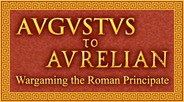I've been painting again. But alas, at the moment what I have painted is still top secret: if I told you what it was, I'd have to kill you. I can't afford the bus fare to the next town, so there's no way I can trot around the globe murdering you all, so I just won't show it to you until next week when Warlord Games (hopefully) release it. Suffice it to say that it's an addition to their Early Imperial Roman range, and to my Early Imperial Roman army. It painted up well. Making a 'temperate' base, with lots of grass, came as a bit of a shock after months of nothing but desert I can tell you!
Now, back to the current project. First of all, Sassanid bamboo and leather shields. Hicksy (sculptor for, and former part-owner of, Bolt Action Miniatures), is probably going to make two masters for me - one for a large 'pavise'-type shield, and another smaller, 'ordinary' shield, both following finds from Dura Europos in Syria. Dura Europos was occupied by the Romans, until besieged and captured by the Sassanids in about AD 260. Most of the military finds (including these, probably Sassanid, shields) come from the context of the siege. Matt of Elhiem Figures is going to cast them for me. Depending how the project works out, I may make the shields available for fellow wargamers to buy. This will, obviously, take some time - making the master, having moulds made, etc. So that will hold up the rest of the Sassanid infantry. There will also be a bit of reworking of the existing figures to do, once the new shields arrive.
In the meantime though, I am still going to be able to get on with Sassanids as well as Romans. I still have Jumbos, Iranian light cavalry, more Savaran armoured cavalry and some Kurdish javelinmen to paint. Dave Toone from Miniature Design Studio is supplying me with some shields for the Kurds - round ones, with attached javelins - to replace the large rectangular 'wicker' shields A&A Miniatures supply. Hopefully, now that the postal strike has been postponed until after Christmas, they'll arrive in the next day or two, and then I can get on again.
Black Powder. Yes, I know, I'm not doing any wargaming related to 'that book' at the moment. But it proved irresistible. And I am glad I bought it - even if I never get to play it. I haven't read all of it, yet, but I have read some, and will read all, of it. It's full of lovely war-porn. If a quick flick through, looking at the pictures and reading some of the 'asides', doesn't make you want to rush out and buy more lead, you aren't a proper wargamer!
I think it's an important book. I think it ought to be 'required reading' for wargamers. It isn't just a set of rules, instead it is an exposition, par excellence, of a particular style and form (philosophy?) of the wargaming hobby - of far wider significance than its claimed AD 1700-1900 remit. That alone makes it well worth a read.
It is the antithesis of the WRG/DBM philosophy. Mr Barker would claim (completely erroneously in my opinion) that his rules are the best simulation of ancient warfare ever, whilst I think that, in reality, they are merely his latest attempt to write a set of rules that seek to cram wargamers into the straitjacket of a 'fair fight' with as few exploitable loopholes as possible, in the vain hope of preventing the 'win at all costs' crowd from killing each other (or, at least, to prevent them having a really bad-tempered argument). It seems to me that this book is proud to be neither of those things.
It is, in a sense, a 'toolbox' full of guidelines for playing wargames - it says things along the lines of 'This is how we did... but you could also do it this way...' Hardly a 'water-tight' rule-set then! And all the more interesting for that very reason, in my opinion - it gives alternative ways of looking at the same thing, and an insight into how rules designers think. A lot of the ideas would be fairly easy to 'lift' and plonk down in rules for other eras.
I think it is a pity that the designers 'caved in' and included a method for devising a 'points system'... If it had been me, I'd like to think I'd have said something rather rude to those parties demanding points systems: this book is simply not about 'that sort of wargaming' at all. I suspect that those who wanted a points system, so they can play 'competitive' games, are going to be disappointed with the rules. I fancy that there will turn out to be more loopholes in the rules than there are holes in a ton of Emmental cheese, and that it won't provide a good framework for competitive wargaming. And hurrah for that!
For me, as much as anything, it's providing a good chance to rethink my approach to the hobby, what I want from it, and how I want my own nascent set of ancients rules to 'feel'.

